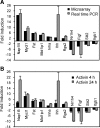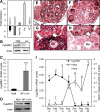Gene expression profiling reveals Cyp26b1 to be an activin regulated gene involved in ovarian granulosa cell proliferation
- PMID: 21084447
- PMCID: PMC3033060
- DOI: 10.1210/en.2010-0749
Gene expression profiling reveals Cyp26b1 to be an activin regulated gene involved in ovarian granulosa cell proliferation
Abstract
Activin, a member of the TGF-β superfamily, is an important modulator of FSH synthesis and secretion and is involved in reproductive dysfunctions and cancers. It also regulates ovarian follicle development. To understand the mechanisms and pathways by which activin regulates follicle function, we performed a microarray study and identified 240 activin regulated genes in mouse granulosa cells. The gene most strongly inhibited by activin was Cyp26b1, which encodes a P450 cytochrome enzyme that degrades retinoic acid (RA). Cyp26b1 has been shown to play an important role in male germ cell meiosis, but its expression is largely lost in the ovary around embryonic d 12.5. This study demonstrated that Cyp26b1 mRNA was expressed in granulosa cells of follicles at all postnatal developmental stages. A striking inverse spatial and temporal correlation between Cyp26b1 and activin-βA mRNA expression was observed. Cyp26b1 expression was also elevated in a transgenic mouse model that has decreased activin expression. The Cyp26 inhibitor R115866 stimulated the proliferation of primary cultured mouse granulosa cells, and a similar effect was observed with RA and activin. A pan-RA receptor inhibitor, AGN194310, abolished the stimulatory effect of either RA or activin on granulosa cell proliferation, indicating an involvement of RA receptor-mediated signaling. Overall, this study provides new insights into the mechanisms of activin action in the ovary. We conclude that Cyp26b1 is expressed in the postnatal mouse ovary, regulated by activin, and involved in the control of granulosa cell proliferation.
Figures






Similar articles
-
Activin regulates estrogen receptor gene expression in the mouse ovary.J Biol Chem. 2007 Dec 14;282(50):36755-65. doi: 10.1074/jbc.M705143200. Epub 2007 Oct 19. J Biol Chem. 2007. PMID: 17951260
-
Activin stimulates CYP19A gene expression in human ovarian granulosa cell-like KGN cells via the Smad2 signaling pathway.Biochem Biophys Res Commun. 2013 Jul 5;436(3):443-8. doi: 10.1016/j.bbrc.2013.05.124. Epub 2013 Jun 6. Biochem Biophys Res Commun. 2013. PMID: 23747729
-
Cyp26b1 regulates retinoic acid-dependent signals in T cells and its expression is inhibited by transforming growth factor-β.PLoS One. 2011 Jan 7;6(1):e16089. doi: 10.1371/journal.pone.0016089. PLoS One. 2011. PMID: 21249211 Free PMC article.
-
Cytochrome P450s in the regulation of cellular retinoic acid metabolism.Annu Rev Nutr. 2011 Aug 21;31:65-87. doi: 10.1146/annurev-nutr-072610-145127. Annu Rev Nutr. 2011. PMID: 21529158 Free PMC article. Review.
-
Activins in reproductive biology and beyond.Hum Reprod Update. 2016 Apr;22(3):342-57. doi: 10.1093/humupd/dmv058. Epub 2016 Feb 15. Hum Reprod Update. 2016. PMID: 26884470 Review.
Cited by
-
Shedding new light on early sex determination in zebrafish.Arch Toxicol. 2020 Dec;94(12):4143-4158. doi: 10.1007/s00204-020-02915-y. Epub 2020 Sep 25. Arch Toxicol. 2020. PMID: 32975586 Free PMC article.
-
A Schwann cell-enriched circular RNA circ-Ankib1 regulates Schwann cell proliferation following peripheral nerve injury.FASEB J. 2019 Nov;33(11):12409-12424. doi: 10.1096/fj.201900965R. Epub 2019 Sep 16. FASEB J. 2019. PMID: 31415184 Free PMC article.
-
MicroRNA dynamics at the onset of primordial germ and somatic cell sex differentiation during mouse embryonic gonad development.RNA. 2018 Mar;24(3):287-303. doi: 10.1261/rna.062869.117. Epub 2017 Nov 29. RNA. 2018. PMID: 29187591 Free PMC article.
-
Complete in vitro oogenesis: retrospects and prospects.Cell Death Differ. 2017 Nov;24(11):1845-1852. doi: 10.1038/cdd.2017.134. Epub 2017 Aug 25. Cell Death Differ. 2017. PMID: 28841213 Free PMC article. Review.
-
A role for retinoids in human oocyte fertilization: regulation of connexin 43 by retinoic acid in cumulus granulosa cells.Mol Hum Reprod. 2015 Jun;21(6):527-34. doi: 10.1093/molehr/gav017. Epub 2015 Apr 15. Mol Hum Reprod. 2015. PMID: 25877907 Free PMC article.
References
-
- McGee EA, Hsueh AJ 2000 Initial and cyclic recruitment of ovarian follicles. Endocr Rev 21:200–214 - PubMed
-
- Epifano O, Dean J 2002 Genetic control of early folliculogenesis in mice. Trends Endocrinol Metab 13:169–173 - PubMed
-
- Barnett KR, Schilling C, Greenfeld CR, Tomic D, Flaws JA 2006 Ovarian follicle development and transgenic mouse models. Hum Reprod Update 12:537–555 - PubMed
Publication types
MeSH terms
Substances
Grants and funding
LinkOut - more resources
Full Text Sources
Molecular Biology Databases

